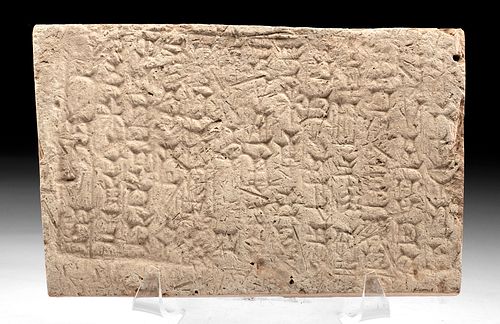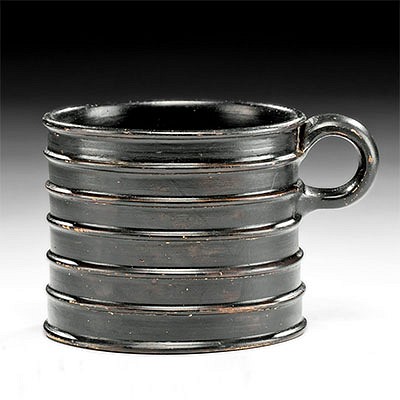Neo Babylonian Clay Tablet of Nebuchadnezzar II
Lot 65b
About Seller
Artemis Gallery
686 S Taylor Ave, Ste 106
Louisville, CO 80027
United States
Selling antiquities, ancient and ethnographic art online since 1993, Artemis Gallery specializes in Classical Antiquities (Egyptian, Greek, Roman, Near Eastern), Asian, Pre-Columbian, African / Tribal / Oceanographic art. Our extensive inventory includes pottery, stone, metal, wood, glass and textil...Read more
Categories
Estimate:
$2,000 - $3,000
Absentee vs Live bid
Two ways to bid:
- Leave a max absentee bid and the platform will bid on your behalf up to your maximum bid during the live auction.
- Bid live during the auction and your bids will be submitted real-time to the auctioneer.
Bid Increments
| Price | Bid Increment |
|---|---|
| $0 | $25 |
| $300 | $50 |
| $1,000 | $100 |
| $2,000 | $250 |
| $5,000 | $500 |
| $10,000 | $1,000 |
| $20,000 | $2,500 |
| $50,000 | $5,000 |
| $100,000 | $10,000 |
| $200,000 | $20,000 |
About Auction
By Artemis Gallery
Mar 12, 2020
Set Reminder
2020-03-12 10:00:00
2020-03-12 10:00:00
America/New_York
Bidsquare
Bidsquare : Ancient / Ethnographic Around The World
https://www.bidsquare.com/auctions/artemis-gallery/ancient-ethnographic-around-the-world-4957
Ancient art from Egypt, Greece, Italy and the Near East, as well as Asian, Fossils, Pre-Columbian, Native American, African / Tribal / Oceanic, Spanish Colonial, Russian Icons, Fine art, much more! Artemis Gallery info@artemisgallery.com
Ancient art from Egypt, Greece, Italy and the Near East, as well as Asian, Fossils, Pre-Columbian, Native American, African / Tribal / Oceanic, Spanish Colonial, Russian Icons, Fine art, much more! Artemis Gallery info@artemisgallery.com
- Lot Description
Ancient Near East, Neo-Babylonian Dynasty, reign of Nebuchadnezzar II, ca. 604 to 581 BCE. A fantastic clay tablet stamped with a dedication to the most famous of all Kings of Babylon - Nebuchadnezzar II. The rectangular tablet has flat faces and sides as well as a slightly off-center stamped inscription. The importance of this tablet is reflected by the fact that the inscription of other similar examples has been deciphered by Professor Lambert of Birmingham University, an internationally renowned expert in this field. Professor Lambert's translation reads as follows: "Nebuchadnezzar, King of Babylon, provisioner of Esagil and Ezida, prime son of Nabopolassar, King of Babylon, am I. Ebabbara, the Temple of Shamash in Larsa I restored as it was before, for Shamash, my Lord." Size: 7.875" W x 5" H (20 cm x 12.7 cm); 6.2" H (15.7 cm) on included custom stand.
Following the defeat of the Assyrian Empire by the Babylonians in 612 BCE, Nebuchadnezzar II rebuilt the city of Babylon on a grand scale. It has been estimated that roughly 15 million baked bricks were used in the construction of official buildings. The bricks are usually square and often bear cuneiform inscriptions, generally made with a large stamp as seen here.
A stylistically-similar example hammered for 5,250 GBP ($6,790.61) at Christie's, London, South Kensington "Antiquities Including the Plesch Collection of Ancient Glass" auction (sale 5951, April 28, 2009, lot 97).
Provenance: private Orange County, California, USA collection acquired before 2000
All items legal to buy/sell under U.S. Statute covering cultural patrimony Code 2600, CHAPTER 14, and are guaranteed to be as described or your money back.
A Certificate of Authenticity will accompany all winning bids.
We ship worldwide and handle all shipping in-house for your convenience.
#153687Minor nicks to stamped inscription, peripheries, and verso, with light encrustations, and minor fading to some cuneiform characters, otherwise intact and near-choice. Light earthen deposits throughout. Inscription is still mostly legible.Condition
- Shipping Info
-
All shipping is handled in-house for your convenience. Your invoice from Artemis Gallery will include shipping calculation instructions. If in doubt, please inquire BEFORE bidding for estimated shipping costs for individual items.
-
- Buyer's Premium



 EUR
EUR CAD
CAD AUD
AUD GBP
GBP MXN
MXN HKD
HKD CNY
CNY MYR
MYR SEK
SEK SGD
SGD CHF
CHF THB
THB














